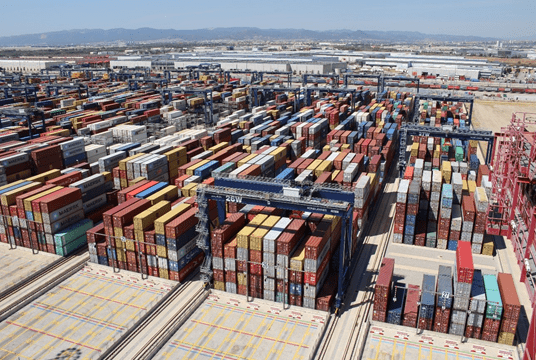The Port of Barcelona opened its first Onshore Power Supply system (OPS) at Hutchison Ports BEST container terminal.
This equipment, which is the first in a container terminal in a Mediterranean port, makes it possible to supply ships with 100% renewable-origin electricity so that they can turn off their engines whilst in the Port of Barcelona and thus reduce their emissions.
The OPS is the first to be deployed under the €200 million Nexigen plan which will enable all the wharves at the Spanish port to be electrified, reducing emissions from port activity. This is a pilot project which, once fully operational, will provide first-hand evidence to understand the needs of this pioneering service and will allow the Port of Barcelona’s customers to become more sustainable as we move forward together towards decarbonisation.
The opening ceremony was attended by the President of the Generalitat de Catalunya, Pere Aragonés; the Regional Minister for Territory, Esther Capella; the Secretary General of Air and Maritime Transport of the Ministry of Transport and Sustainable Mobility, Benito Núñez; the mayor of El Prat del Llobregat, Lluís Mijoler; first deputy mayor of Barcelona, Laia Bonet, the President of Puertos del Estado, Álvaro Rodríguez Dapena; and Port of Barcelona President Lluís Salvadó. Also present at the event were Clemence Cheng, Managing Director at Hutchison Port Holdings Europe and Chairman of Group Sustainability Committee, and Guillermo Belcastro, Hutchison Ports BEST CEO, among others.
Pere Aragonès, the president of the Generalitat (Catalan autonomous government), stated that the OPS “is a fundamental project for the future of Catalonia”, adding that “with the entry into operation of the first charging point for ships in a container terminal we are again demonstrating Catalonia’s leading role in Europe and in the Mediterranean.”
Clemence Cheng, Managing Director at Hutchison Port Holdings Europe and Chairman of Group Sustainability Committee, emphasised that “the OPS represents a quantum leap towards our commitment to reduce BEST’s carbon footprint by 80% by 2030 and become an emissions-neutral terminal in terms of operations by 2040, a vision that is now even closer with the official certification of our carbon footprint.”
Installed in parallel with the terminal enlargement works, building the OPS meant bringing a new 3.000-volt medium-voltage network via 3,000 metres of cable to the wharfside, where three specifically designed connection boxes were installed to make them compatible with terminal operations. These connection points, combined with the OPS’s ability to supply up to 8MW of power, allow two vessels to be connected simultaneously.
The new OPS system was manufactured in Denmark by PowerCon according to the specific needs of the Port of Barcelona. Once ships roll out their cables to the wharf and plug into the connection points, the electrical current can be adapted from the 25,000 volts received from the grid to the 6,600 needed by container ships, modulating its frequency to 50 or 60Hz, according to the needs of each vessel.
This flexible system makes it possible to maximise the connections made with the different ships arriving at BEST, taking full advantage of the potential of the OPS. Around 92 connections will be made during the first two years of operation of the OPS, which will be in the pilot phase. 2,500 tonnes of CO2 will thus be eliminated annually, the equivalent of around 135,000 cars driving 30 kilometres per day every year. As of year three, it is expected to progressively increase the number of annual connections, with the corresponding increase in the reduction of emissions.
The ultimate aim of wharf electrification at the Port of Barcelona is to improve air quality around the Port of Barcelona.







